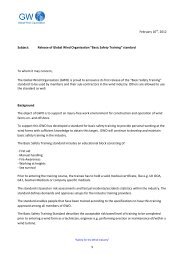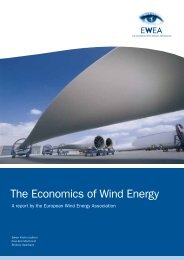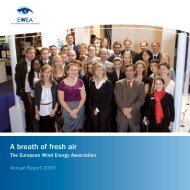Offshore Electricity Infrastructure in Europe - European Wind Energy ...
Offshore Electricity Infrastructure in Europe - European Wind Energy ...
Offshore Electricity Infrastructure in Europe - European Wind Energy ...
Create successful ePaper yourself
Turn your PDF publications into a flip-book with our unique Google optimized e-Paper software.
esults<br />
1986 (the Cross Channel l<strong>in</strong>k connect<strong>in</strong>g France and<br />
Great Brita<strong>in</strong>). In contrast, the experience with HVDC<br />
VSC technology is much shorter. The largest operational<br />
VSC <strong>in</strong>terconnector is Estl<strong>in</strong>k (350 MW, 2006).<br />
While equipment manufacturers expect VSC systems<br />
of up to 1,000 MW to be available <strong>in</strong> the com<strong>in</strong>g years,<br />
it is likely that the VSC power capacity will rema<strong>in</strong> lower<br />
than that available for CSC for the next ten years.<br />
The advantages of VSC over CSC technology are the<br />
ability to <strong>in</strong>dependently form a voltage reference which<br />
is very useful at an offshore hub for the connection of<br />
a w<strong>in</strong>d farm, its compact size (and weight) compared<br />
to CSC, and its higher operational flexibility with regards<br />
to the direction of power flows. At present the<br />
converters do <strong>in</strong>cur larger power losses than their<br />
CSC equivalents. In conclusion, the advantages of<br />
VSC technology <strong>in</strong> an offshore environment mean that<br />
it will be the HVDC technology of choice for the connection<br />
of offshore w<strong>in</strong>d farms. However, for those<br />
<strong>in</strong>terconnectors requir<strong>in</strong>g a large capacity but not the<br />
specific features of VSC technology, the <strong>in</strong>terconnector<br />
project developers will probably opt for the less<br />
experimental, higher commercially available capacity<br />
of CSC technology, particularly if no w<strong>in</strong>d farm connections<br />
are anticipated <strong>in</strong> the short term.<br />
4.3.2 Hub-to-hub solutions –<br />
case study evaluation<br />
The development of <strong>in</strong>terconnectors between w<strong>in</strong>d<br />
farm hubs would be the beg<strong>in</strong>n<strong>in</strong>g of a truly meshed<br />
offshore grid. Instead of connect<strong>in</strong>g w<strong>in</strong>d farms <strong>in</strong>dividually<br />
to shore and <strong>in</strong>terconnect<strong>in</strong>g the countries<br />
with a direct <strong>in</strong>terconnection, the <strong>in</strong>terconnection can<br />
be built between the w<strong>in</strong>d farm hubs. The hub-to-hub<br />
solution implies that the offshore w<strong>in</strong>d farms, along<br />
with their hub connection to shore, would be built first<br />
or <strong>in</strong> parallel with the hub-to-hub <strong>in</strong>terconnector. This<br />
development may be considered w<strong>in</strong>d driven as w<strong>in</strong>d<br />
farm hub connections are the driver to <strong>in</strong>stall large<br />
HVDC VSC converters offshore with trade as a potentially<br />
beneficial add-on. This is similar to the option of<br />
divid<strong>in</strong>g the w<strong>in</strong>d farm connection <strong>in</strong> order to connect<br />
to two countries as discussed <strong>in</strong> Section 4.3.1, but<br />
is <strong>in</strong> contrast to the option of connect<strong>in</strong>g w<strong>in</strong>d farms<br />
to planned <strong>in</strong>terconnectors where <strong>in</strong>ternational power<br />
exchange is mostly the key driver.<br />
Technically, to operate efficiently a complex multi-term<strong>in</strong>al<br />
meshed configuration is likely to require the use<br />
of HVDC VSC technology and the availability of fast<br />
HVDC circuit breakers <strong>in</strong> order to limit the propagation<br />
of faults throughout the whole network. Equipment<br />
manufacturers have confirmed to the <strong>Offshore</strong>Grid<br />
FIGURE 4.12: PROTOTYPE GRIdS WITh dIFFERENT cONFIGURATION IllUSTRATING ThE APPROAch FOR cOMPARISON OF REAl<br />
SITUATIONS IN ThE cASE STUdY [3]<br />
Country A Country B Country A<br />
Country C<br />
Country B<br />
Country C<br />
(a) hubs with <strong>in</strong>tegrated <strong>in</strong>terconnectors (b) hubs and po<strong>in</strong>t-to-po<strong>in</strong>t <strong>in</strong>terconnectors<br />
46 <strong>Offshore</strong>Grid – F<strong>in</strong>al Report









